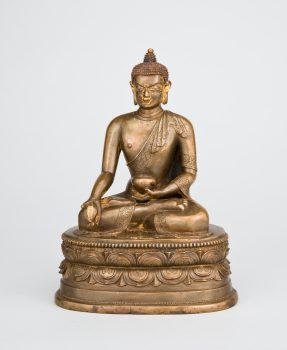Mongolia
18th century
The right hand is extended in a giving gesture.
Mongolia
18th century





This smoothly modelled sculpture shows the Medicine Buddha on a high lotus seat with both upward and downward facing petals and a beaded edge. He holds a medicinal Myrobalan fruit in his right hand and a bowl with nectar in his left.Tibetan Buddhism was first introduced to Mongolia in the thirteenth century by Buddhist teachers who were patronized by Qubilai Khan (1215–1294), the grandson of Chingghis Khan and an emperor of China. Mongolians traditionally held shamanistic beliefs, but between the sixteenth and eighteenth centuries many incorporated Buddhism into their belief systems. Similarly, Tibetan medicine was integrated with the Mongolian indigenous healing practices and is widely practiced today.
A meditation technique primarily used in tantric practice that involves imagining a deity in one’s mind or imagining oneself becoming a deity and carrying out various activities. Such techniques are intended to help a practitioner transform ordinary perception and achieve enlightened qualities.
While the primary religious goal for followers of Buddhism is enlightenment, many of the practices also serve secular goals related to daily life, including ethical conduct and cultivating well-being.
A contemplative practice in which a person uses concentration and visualization to achieve aims such as transforming the mind and generating feelings of compassion. Techniques include focusing on breathing or visualizing oneself as a deity.
An awakened being who understands the true nature of reality and is free from the cycle of birth, death, and rebirth. While there are many buddhas, Siddhartha Gautama is the historical Buddha, whose teachings became the foundation of Buddhism.
Mongolians have been widely active in the Tibetan Buddhist world, playing a key role in Tibetan culture, politics, and relations with China. In the 13th century, the Mongol Empire—the largest contiguous empire in world history—facilitated the spread of Tibetan visual culture.
Get the latest news and stories from the Rubin, plus occasional information on how to support our work.